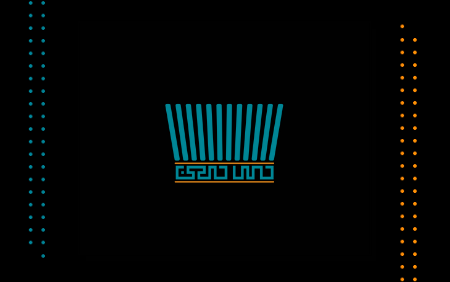"Inlay": Khatam-Kari
Definition of Inlay in the Persian Encyclopedia is:” The art of decorating objects in mosaic-like shapes with small triangles. Various Khatam pattern has always been in regular geometric shapes. These geometric shapes are formed by placing small triangles next to each other. Artists make triangles from wood, metal and bone. Whatever the triangles are smaller and more elegant, Khatam becomes more qualitative. At least three triangles are used to construct the smallest geometric unit in a Khatam pattern, and for the largest one, there is a maximum of four hundred triangles.
”This art came to Iran in this modern fashion before the Safavid dynasty and during the Mongol Ilkhanate period and following the creation of a direct relationship between Iran and China. Some other scholars also believe that Inlying was founded in the Deylaman era in Iran and in the city of Shiraz, and peaked in the Safavid era, because, on the one hand, the government supported the artists, and on the other hand, the trade relations with the far and near countries helped to expand the art of Khatam. Before the advent of Islam, Khatam-sazi(making-khatam) has become popular in Iran and the way it worked; was the cubes were cut to the sides of four millimetres, with a single coloured wood and they were nailing and mount on a plate with a variety of designs and this manner was common until several centuries after Islam. At present, there is an Inlying pulpit with this method in the Atigh Jame' Mosque of Shiraz, which has passed more than a thousand years since its construction.
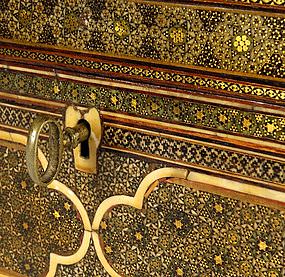
Required items for Inlay
Work tool
Metal clamp, sharp rasp, hammer, pincer, masalas sab, sim sab-dar saw, Moghar, metal meter, fixed ruler and tir-dar ruler, Set square and compasses.
This art has two steps:
1.Making-Khatam, which includes operations such as Khatam designing preparation of materials, cutting raw materials, combination and creating flowers, and ultimately making "ghame"(A rectangular cube object that has an average length of 40 cm and a width of 10 cm and a diameter of 3 cm and made from wood or Khatam) and will be cut and finally initial Khatam is prepared.
2. Inlay includes the design of the substructure, design of the sticking the Khatam layers on the underlying board, polishing and working of Inlay objects.
Khatam construction Method: In Inlying, artist cut wood, bone or metal into triangular prisms and arrange them together in such a way that the transverse section of these triangles have regular geometric shapes, then thin slices are arranged in a special order on a thin wooden sheet with glue (sirish), and after the drying, master installing the sheets on the objects and it’s ready to decorate.
Wood types are one of the most important materials of Khatam-sazi, which includes Jujube, Sour Orange, Maple, Walnut, Acer monspessulanum, Tabrizi, Box, Ebony, Betel and Logwood. Types of bones are also used to make Khatam, due to their strength and white colour, including camels, horses and cow, as well as natural and artificial ivory of elephant that are very useful in Khatam. For Khatam's strength and care, colored metals are used in Khatam-sazi. Silver and aluminium are used for white and brass are used for yellow. Artist must take care to provide the wood needed for proper colour and texture and it must have not knots or cracks. Metals should also have a good alloy.
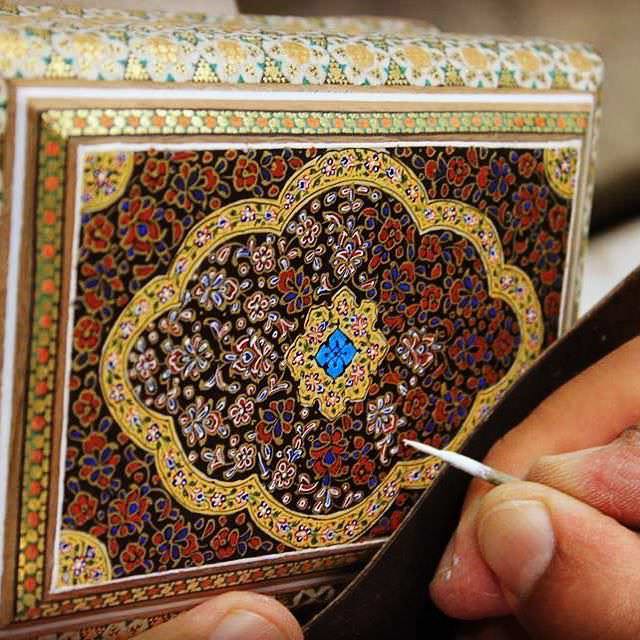
Tools for making-khatam
Grind, Teng, Saw, Rasp, Set square, compasses, Hammer, Pincer, Moghar, Press.
Materials of making-khatam
Wood: Maple, Ebony, Jujube, shah choob, zelkova, Logwood, Sour Orange, Box.
Metal: Gold, silver, copper, brass and aluminium wire.
Bone: Bone of the arm and hand leg of camel or horse, the ivory of the elephant, artificial bones.
Green colour: This colour is made up of a combination of salt-ammoniac (ammonium chloride), copper filings and vinegar. Sliced bones are placed in a coloured solution container and exposed to sunlight for six months. Nowadays, since it's hard to make a camel bone, the sour orange tree is used instead of camel’s bone and to colour it, we can use a special green colour of wool dyeing.
Khatam Lubrication:
Basically, the surface of a Khatam is lubricated for two reasons: the shine of Khatam and its protection against moisture, heat and cold. Sandless and polished oil or Jal oil (Pine Tree Sap) were used in the past, later using Hawilux oil and now using polyester.
Khatam production stages:
Firstly, different types of wood and bones are prepared in different colours and cut with their special tools, with 30 cm in diameter and 1 to 2.5 mm in diameter. And the triangles are prepared from them which after the rasping, all sides of it are customized and in accordance with the pattern and to complete the design, triangular-formed wires is needed which there are various stages to prepare them. Then, in order to make Khatam, the desired pattern is drawn by the master. These wooden, bone and metal triangles are arranged by the skilful hands of the artist and glued together by glue. They get tightened by the thread, and this will make the "blade". After a few hours, the thread is opened and the sides of rasped pattern and four of blades that are made put together. And again glued together. The result is "Tugloo". The next stage, known as "Golpichi," is made up of a circular wire, which is arranged in a regular hexagonal form, called "Shamse". Around every six sides of the wires is glued together by glue. It is tied up with a thread and the result is a star design. These designs are repeated so that they are pressed according to the design required. With several steps of cutting and glueing the very thin layers of wood around it, an initial Khatam design will be created. All these steps from the beginning to the present include more than 400 work steps.
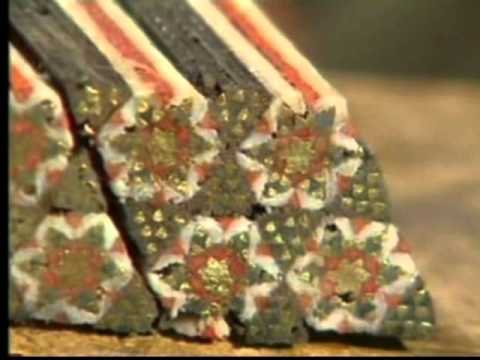
Qualitative Khatam Features:
The level of work is smooth and there is no empty place in Khatam.
The uniformity of colours and materials used in making Khatam.
No change in colour and shape.
Repairs and calks are not specified at the surface of Khatam.
All flowers and shapes, angles and sides are symmetric.
The basis and structure of the pattern be accurate and has engineering-base so that all dimensions are identical, symmetrical and equal because if the chassis was not accurate, the best Khatam will not lustre and the whole scheme is ugly. That's why a Khatam maker artist must be a carpenter too.
Painting and coating the product must be skilful and without any damage and any defect.
The smaller the roles and triangles the greater the quality and value of the work.
Khatam-sazi works at different periods
Safavid era is the brightest period of Making-Khatam in Iran.
During the Qajar period, the entrance to the treasury and shrine of Hazrat Abdul Azim (AS) and the entrance of the ancient Iranian museum are made which are the most beautiful Khatam of the world.
Inlay patterns
Generally, three types of designs or patterns are used in the art of Inlying, based on all of these designs is the use of wood, bone, shell, and metal in the form of wire. These designs include the pattern of text, the margins and the single flowers. Some of these designs are two-round clouds (abre do Dori), 7 shams, barge moo, pigeon, allahei, butterfly, sun, jar, spear, por sim, taghi, tokhme dar and toopi. Some of these plans will be discussed later. It is necessary to recall that these designs were photographed from the archives of Professor Ayoubi.
"A combination of regular polygons," "the art of decorating wooden objects in the form of mosaic," "Carving a design by wooden parts and other materials that will later be installed on a wooden floor"...These are sentences attracting the attention of viewers in any search made on Khatam and Inlying. But why is this art called "Inlying "? And why "Khatam"? In a search in the Dehkhoda dictionary, we arrive at one of the meanings of the word Khatam, which is as follows: "The seal and the ring with which it is stamped; and it is the tools and supplies of the kings and put it to the decoration for fingertips. And so it was called Khatam because the kings' manuscript ended with it."
It was probably Khatam, which the kings had on their hands, made of wood or bone, and their name or nickname was written with pieces of wood and bone, which today is called the art of mosaic-wood or Khatam.
What is Inlying? The art of mosaic-wood that has been given to this art.
Currently, the oldest thing that is decorated with Khatam is a thousand-year-old pulpit that is available in the Shiraz Atiq mosque.
Making Khatam has various stages, and the person who makes Khatam must be familiar with various tools and carpentry techniques. In making Khatam, the needed raw are kinds of wood, such as Ebony, Maple, walnut, Logwood, Jujube, Sour Orange, Montpellier maple, populous and various types of bones such as bone and ivory, camel bones and horse bones. Tools like metal wires, hammer, saws, shaver, rasp, Wood glue and glue are also used.
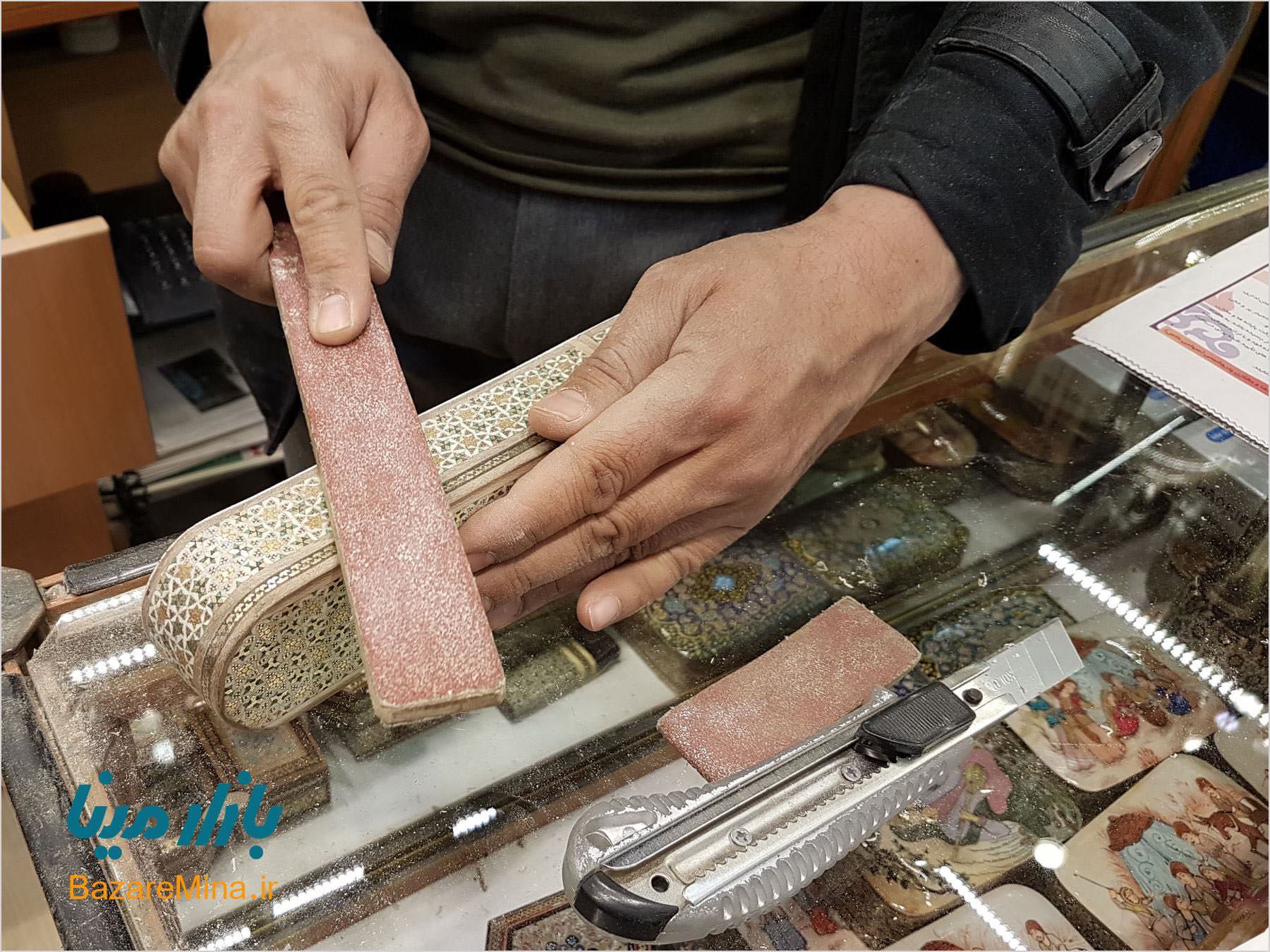
In the production of Khatam, at first, they cut the necessary materials, such as wood and bone types, in very small geometric dimensions. And they bring them together in different geometric shapes with copper or aluminium wires. The master sticks these shapes together on the desired board after rasping and sticking together by glue.
In Khatam-sazi, the following materials are used:
For the production of Khatam products, various materials are used:
- Wood types such as Ebony, Areca palm, Logwood, Jujube, Sour Orange, Maple, Acer monspessulanum, Tabrizi, Box.
- Types of bones and ivory, such as ivory elephant, camel bone, cow bone and horse bone.
- Types of metal wires like brass, silver and sometimes gold wire
- Shell
- Nakh-Parak
- Glue
- Sieve
In the following, we will mention the characteristics and properties of each of these materials and their application.
Ebony wood:
This kind of wood was used to make black triangles in the old days. This wood has significant strength and is therefore rare and expensive on the market.
This wood is mostly made from India, which is currently rarely used by Khatam makers due to its high cost.
Areca wood:
Although Khatam makers have gradually turned into bean wood, which is used for black and dark browns and more in the Khatam margin, due to the cost and shortage of ebony wood, but now, since this type of wood is found more often in India And it's rare in the country, it does not have a significant use in Khatam-Sazi. In addition, if Khatam makers want to use this type of wood, often provide it from the old desk and chairs that are made of Areca wood.
Walnut wood:
Most Khatam makers now use walnut woods to produce black triangles, which, after cutting the triangles, painting them with black chemicals colour.
Logwood wood:
The Logwood wood has a natural red colour and is more solid than the same type. Given these characteristics, Khatam makers used Logwood wood to make red-brown triangles in the past, but this wood is also rare and expensive at the moment, and it’s found in India.
Jujube wood:
Nowadays, this type of wood is somewhat substituted for the Logwood wood, and Khatam makers use jujube wood, which is reddish-brown, and it mostly founds in Khorasan and Shiraz and its surroundings, Yazd and its surroundings, Qom and Chahar Mahal-o-Bakhtiari. The jujube wood is often turned red with artificial and chemical colours.
Sour Orangewood:
Sour Orangewood is mostly found in the provinces of Fars and Mazandaran. This type of wood has a bright brown natural colour that, after cutting the triangles, it turns red, yellow, or black with artificial and chemical colours and used in Khatam.
Maple Wood:
The natural colour of this kind of wood is brown, and after cutting the Khatam's triangle, with artificial and chemical colours, it turns red or yellow.
Acer monspessulanum wood:
Khatam makers use Acer monspessulanum wood in the form that first creates a groove in the form of a triangle and uses it to rub the triangles and the six sides. They actually put cut triangles inside this triangular groove and smooth the sides of the triangle by rasp and then polish it. In fact, they use this wood to moulding the triangular form and the edges of six sides.
Tabrizi or Populus wood:
The back of Khatam, in fact, its linings, comes from this very soft, white wood. The diameter of the liners is about one millimetre. they create narrower grooves with the saw so that it's more smooth, and the Khatam maker can prepare Khatam better in whatever form it wants and stick to the objects.
Buxus Wood:
Buxus wood has high strength and its natural colour is yellow. This wood is found in the lush green forest of Mazandaran.
Elephant ivory:
Mostly natural ivory is found in India and the continent of Africa, and the former was used to make the white colour on Khatam, but currently, due to its high cost, it is less used in Khatam. While due to the beauty and strength that it gives to Khatam, it is still used in the first-class Khatam. For this purpose, the ivory that has Cylinder shape, divided into two pieces from the middle, And they take layers from each side with a thickness of 2 to 3 mm and then form it in the form of different triangles. Currently, Khatam maker often uses artificial ivory.
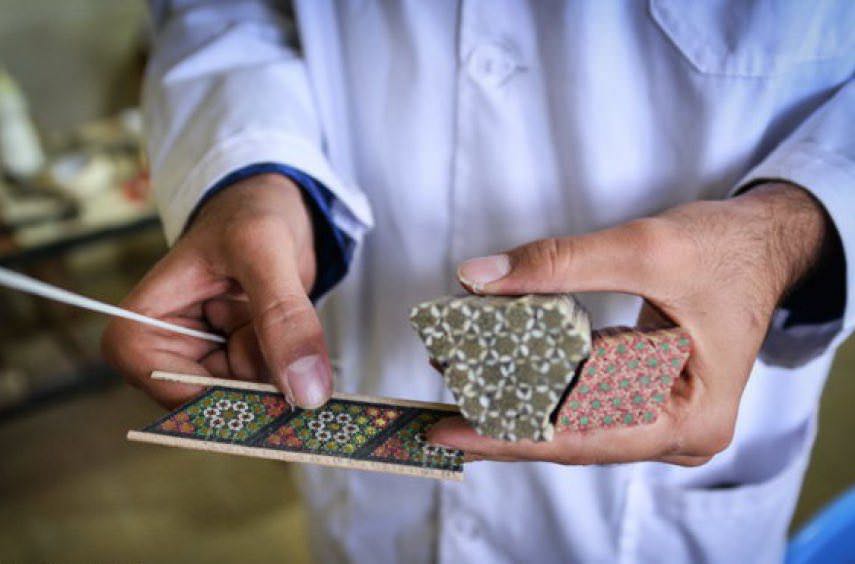
Camel's bone:
The natural colour of the bone of camel is white and uses it to produce different triangles and colours it in different colours with artificial colour. How to use the camel's bone is that after cutting the eight camel legs, they are cleaned with lime water and placed in lime water and stay in lime water for six months to remove bulk and bone fat, so that the bone be completely white. Then they scratch it with a special ax and then cut triangles and layers from it that are used in Khatam next to wood and other metals. The camel's bone is used as a natural colour in Khatam or make it green with chemical colours.
Horse Bone:
The natural bone is white. This bone also brings in various colours, especially the green colour, using chemical colours, and mixes it with another triangle.
Because the horse's bone is more colour-tolerant than camel's bone, its use is more common. Today, in addition to the bone of the camel and bone of the horse, they also used cow's bones, which is more available.
Metal wires:
In Khatam-sazi, they use brass to make golden and shiny yellow. Of course, in the past rarely gold was used in Khatam. In some types of Khatam, silver and sometimes aluminium is used. To make the triangle, brass wire is used for golden yellow and silver wire are used for shiny white. In the past, for the preparation of wire triangles, by means of a device called "Hadideh or Die", they were put into a three-sided form and shape.
And hammered on the anvil with a special hammer to prepare the desired wire for embedding in Khatam, but they use the roll to form triangles.
After the triangles have been removed from rolled, the prepared triangular-shaped wire has been arranged in certain sizes and placed in the grooves of the Acer monspessulanum wood. Then the wires have been rasped and shiny. In the past, Khatam makers used copper for the golden yellow colour, which, of course, does not have a stable colour and does not have the necessary strength for Khatam.
Currently, most Khatam makers use brass wires to supply yellow gold, which does not have enough colour stability.
Shell:
The use of the shell in Khatam-sazi brings more beauty and adds to the quality of Khatam, but today it is less used due to the high cost of this product and its scarcity. Khatam makers supply shell from Persian Gulf ports and the Oman Sea and they are now used to provide shiny and glow white in first-class and excellent Khatam.
Parak thread:
In making Khatam, different threads with different thicknesses are used for triangles, blades and flowers. The most famous of thread called Perk.
Glue:
Glue is used to stick Khatam on the various dishes and objects. This glue should be heated only when needed because its reheating reduce its adhesion. To warm the adhesive, place it in a double glazed) double-wall (container. the dish is heated in the first glaze, and the adhesive in the second wall become liquid and semi-heat and does not burn. In the Khatam-sazi industry, another adhesive is also used, called white glue, which is used in cold form. The white glue, which has high strength and durability, is naturally derived from gum (resin) and is used to stick the bones that are placed in the corners of the Khatam dishes and products.
Sieve:
After completing Khatam and stick it on the objects, they work on it and polish the Khatam surface. Then, in three turns, cover Khatam with a special sieve. The important point at this stage is that the sieve must operate equal and aligned on the surface of Khatam because we don't want to create bumps and dents at its surface and doesn’t reduce their beauty and quality. It should also be carried out in an indoors and covered place and away from dust so that the suspended particles in the air do not sit on the surface of the sieved objects. The Uncovered surface of Khatam products, such as the back of the frame and inside the box, etc, should be ground and sealed and killed. However, all surfaces of Khatam and surfaces that remain in the form of wood should be covered with the sieve to prevent penetrating from moisture. Today, many Khatam makers, instead of use sieve in this way, cover Khatam products with a kind of Jall named Polisert, which is a glass-like and non-burning material.
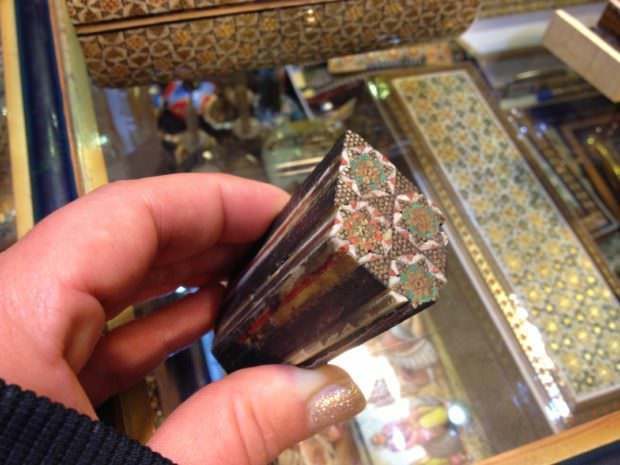
Equipment and tools:
The tools used in the preparation of Khatam include saws, presses, different types of wood rasp, hammer, rasp, pincer, grate, Dye dish, brush, scissors for cutting brass wire, nipple, needle nose pliers, Screwdriver and sandpaper (rubber). In some workshops, Khatam cutting machines are also used to increase work efficiency. Other tools for making-sazi is wire mill, which brings metal wires into the triangular prism. The other tool is a Board which creates grooves or prism that is a flat board and there is a groove in the shape of the triangular prism on it.
Khatam production process
Khatam is one of the traditional arts that requires a lot of precision and tolerance to build it. The construction of Khatam involves various steps of stringing "EL" to processing Khatam.
*Pa’rreh Pichi
*To make Khatam, the sketch will be drawn by the master, and these wooden, bone and metal triangles will be placed and stick together with the skilful hands of the artist along by glue. Then they get tight by the thread. This is what is termed "Pa'rreh".
At this step, three Equilateral sections will be aligned with another triangle to form a larger triangle.
- Convert "EL" too thin strings:
This is done by the saw. After cutting "L", but the strings inside a groove called "Tonge-masalas-saz" and they grind to make the strings uniform.
- Cutting and stringing (make "EL")
"EL" refers to sheets of thickness from one to three millimetres, which is obtained by cutting pieces of wood. These sheets are placed on "Ghame'.
- Shesh Pichi:
The term refers to the sum of six triangles next to each other, which triangular norm is to the outside and its vertex is to the inside.
- To galoo
At this step, four (pa'are)blades are placed together. Tugloois mostly used among Khatam flowers.( After a few hours, the thread is opened and the sides of the pattern have been rasped, and four of the blades(pa'are) are put together and re-bonded with glue, resulting in a "Tugloo".)
- Gol-bandi
gol-bandi is a pattern created by the combination of triangles, Pa'arehs(blades) and (sheshha)sixes.
- Loz-bandi
At this step, the Khatam flowers are placed together in the form of a diamond and its inner angles are filled with the Tuglo.
Each diamond is about 62 centimetres.
- Khatam Press :
At this step, the diamonds are placed on two "L" and the press is heated up by glue.
- Cutting-Ghame
After pressing Ghameh, cut it into 20 pieces.
- Khatam Lining
At this step, one cut side of the Khatam is limited. The thickness of this lining is about one millimetre.
- grinding:
At this point, Khatam's wooden back and its lining will grate and grind.
- stick:
This step involves stacking the sheets of Khatam with adhesive or isinglass (glue) on the desired objects.
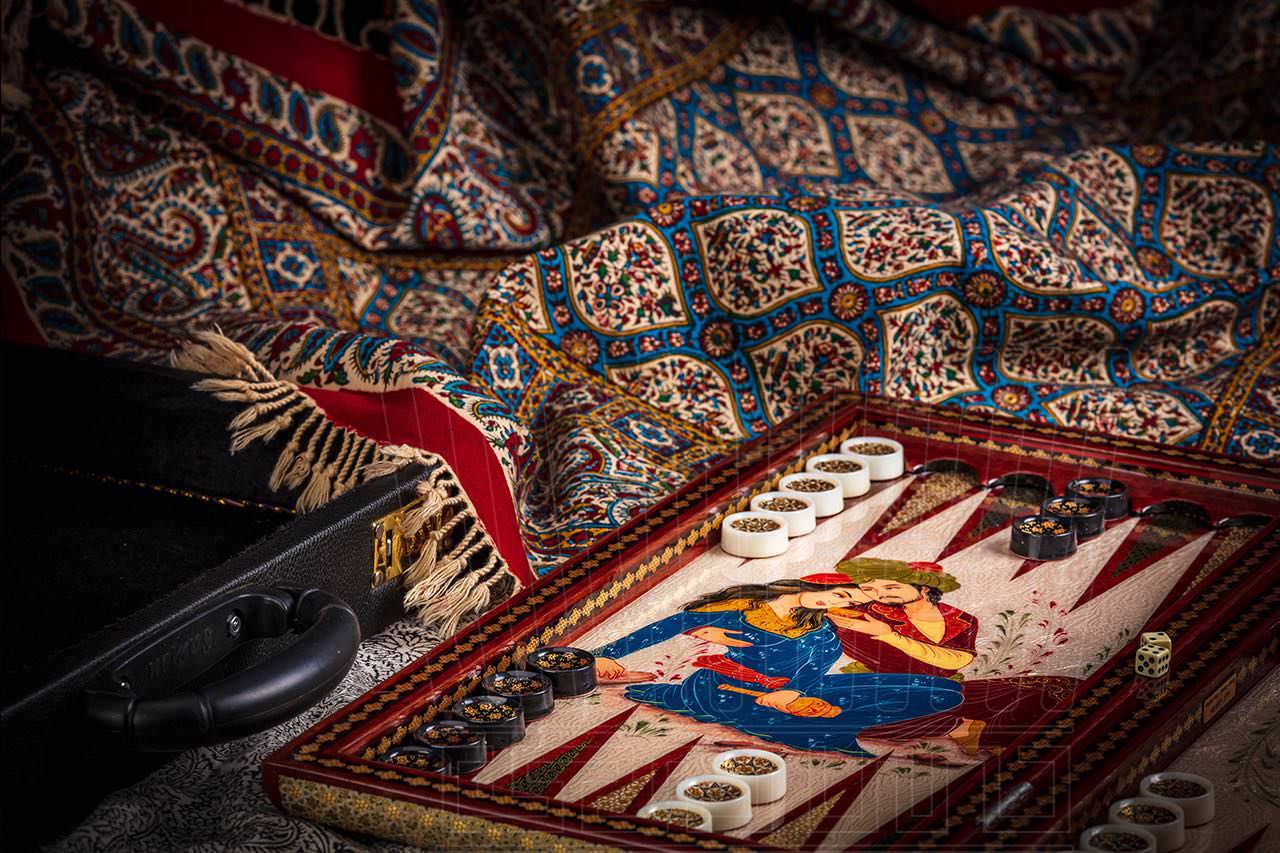
- The final step:
The final stage of Inlying includes priming, rubbing, processing and polishing (polyester).
